|
Foundry, SNAP Given Boost in FY04
Budget; Cyclotron Cited for Closure
Foundry, SNAP Given Boost in
FY04 Budget;
|
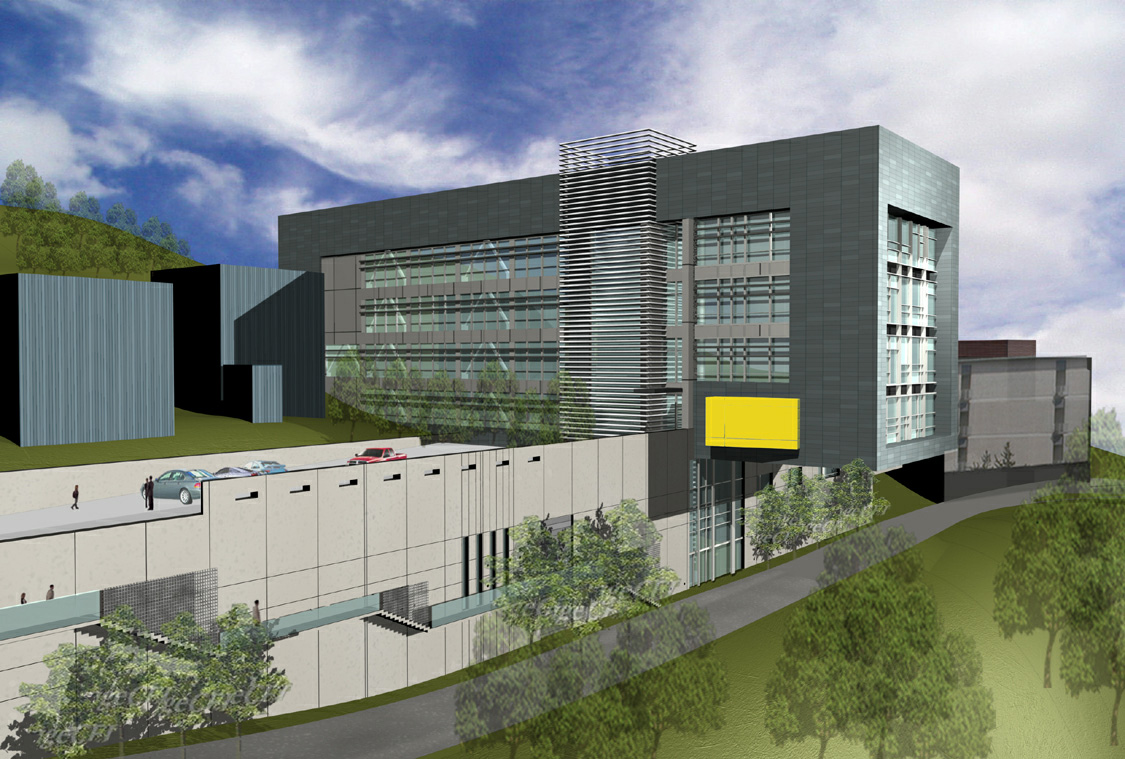 Architectural rendition of the Molecular Foundry nanoscale center, scheduled to open for business by 2006. |
Also encouraging is a $1.4 million increase in the operating budget for the Advanced Light source, and a $2 million allocation for Phase II rehabilitation of the Building 77 engineering shops area. Office of Science funding commitments in the Genomes-to-Life, advanced scientific computing, and carbon sequestration programs hold promise for Berkeley Lab’s role.
The news, however, was not all good. Among the recommendations was one for the termination of Berkeley Lab’s historic 88-Inch Cyclotron, which over its illustrious 40-year history has been one of the field’s most productive facilities for the analysis of nuclear structure and behavior.
Office of Science Director Ray Orbach was quick to point out that the decision was not based on the cyclotron’s performance. “It’s a fabulous machine,” he told reporters. “It has educated a large fraction of the physics community, and it’s been one of the most productive machines we’ve had. But we just had to choose between it and other priorities in nuclear physics.”
That comes as small consolation to the dozens of scientists, staff members, postdocs and students who call the cyclotron home for their work. Senior Lab officials were taken off guard by the unexpected announcement and expressed “great disappointment” in the decision.
“If it weren’t for the news about the 88-Inch, I would call this a positive budget for Berkeley Lab, under the circumstances,” said Reid Edwards, head for Public Affairs. “In a very difficult financial climate in Washington, I think we were treated fairly.”
He cautioned that the budget proposal for FY04 is only the first step in a lengthy review process that includes Congressional hearings and committee counterproposals. And he said everyone must remember that the FY03 budget still hasn’t been passed. The government is operating on a continuing resolution pending the final agreement on this year’s numbers, which could come in a matter of weeks. In the meantime, no new projects can begin.
That shouldn’t affect the Foundry which, if funded as proposed, would be able to break ground in early 2004 and open up for business later in 2006. The user facility will feature a six-story, 86,500-square-foot main building and a smaller adjacent utility plant, both situated on the hillside between the National Center for Electron Microscopy (Building 72) and Building 66 on Lawrence Road.
When operational, the Foundry will be used at any one time by about 135 people, including permanent and visiting scientists, staff and students. Research will be organized around six core nanoscience areas — inorganic nanomaterials, organic polymer/biopolymer synthesis, theory, nanofabrication, biological nanostructures, and imaging and manipulation.
The $85 million project will be the largest at Berkeley Lab since the Genome Sciences Building (84) was completed in 1995.
The SNAP augmentation would bring annual funding to $8.25 million. The new funds are allocated to complete a conceptual design for the satellite-based telescope by 2006. SNAP proposes to orbit a 1.8-meter reflecting telescope fitted with a billion-pixel CCD camera, the largest astronomical CCD imager ever constructed. By repeatedly imaging just one or two large patches of sky, SNAP could gather 2,000 type Ia supernovae in a single year, 20 times the number from a decade of ground-based search. The supernovae are used as “standard candles” for calculations that can help determine the age, and ultimately the fate, of the universe. Because of enhanced sensitivity to infrared light above the atmosphere, many of these new supernovae would be at distances and redshifts far greater than any yet found.
Both the Molecular Foundry and SNAP fit nicely into the research priority areas identified by Orbach on Monday for the Office of Science. They include nanoscale science and engineering, exploring the fundamental nature of energy and matter, Genomes-to-Life, climate change, next generation computing architecture, and teacher development. Although the details are still unclear, it is likely that Berkeley Lab will play a role in several of those.
The Joint Genome Institute, in which Berkeley Lab is a major partner, also hopes to benefit from the budget proposal. The Office of Science’s Biological and Environmental Research (BER) budget sets a goal of sequencing 12 billion high-quality base pairs in FY2004, and completion of the draft sequence and assembly of the Xenopus tropicalis (African clawed frog) genome.
DNA sequencing for the Genomes-to-Life program will be conducted at the JGI.
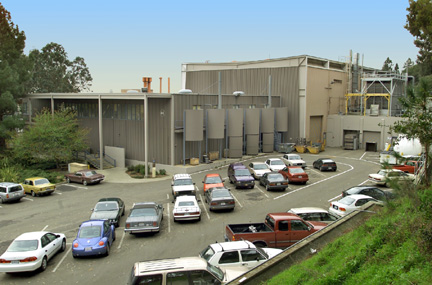 The historic 88-Inch Cyclotron has been tabbed for closure by the President’s FY2004 budget. |
Also included in the FY04 proposal is $950,000 to continue the removal of waste products, in particular concrete shielding blocks, from the decommissioned Bevatron. It also provides $1 million to begin fabrication of GRETINA (the Gamma-Ray Energy-Tracking In-beam Nuclear Array), a segmented germanium gamma-detector that will be used to study nuclear decay and structure of exotic nuclei.
The most significant increases in the Office of Science budget were in the areas of new computing architecture (+ $7 million), nanoscale science (+ $64 million), Genomes-to-Life (+ $24 million), climate change (+ $22 million), and facilities upgrades (+ $22 million). Overall, the proposed FY04 Science budget for the DOE is $3.3 billion, up 1.4 percent over the FY03 request.
The Energy Efficiency budget, from which much of the funding for Berkeley Lab’s Environmental Energy Technologies comes, would remain about the same at FY03, with significant increases proposed in the areas of hydrogen technology and vehicle and fuel cell programs.
Details on the Office of Science budget proposal, including Director Orbach’s PowerPoint presentation in conjunction with Monday’s rollout, can be found at http://www.science.doe.gov./
By Charles Osolin
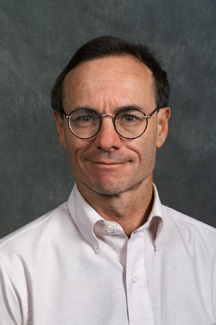 |
Berkeley Lab geneticist and medical researcher Edward (Eddy) Rubin, M.D., has been named director of the U.S. Department of Energy’s Joint Genome Institute (JGI). Rubin has also been named director of Berkeley Lab’s Genomics Division. He had been serving as interim director of JGI since spring 2002 and was selected for the position after a nationwide search.
Berkeley Lab Director Charles Shank announced the appointment on behalf of the three University of California laboratories that manage the JGI: Berkeley Lab, Lawrence Livermore National Laboratory, and Los Alamos National Laboratory.
“Dr. Rubin’s international reputation in genomics studies makes him an ideal candidate for the JGI directorship,” Shank said. “All of us (at the DOE laboratories) owe him a tremendous debt of gratitude for his exemplary leadership thus far, and I know I speak for all of us when I express optimism and excitement about the possibilities for the future.”
Rubin said he was “enormously enthusiastic and optimistic” about the JGI’s “unique capabilities and strengths” — not only for its world class genome sequencing capacity but for its emerging role as a cutting edge biological research center.
“JGI is a national resource for sequencing and it will continue to build upon that capability, but it is also the substrate for important biological research,” he said. “My goal is to link genome sequencing to science.”
Rubin received his B.A. degree in physics from UC San Diego, his M.D. from the University of Rochester Medical Center, and his Ph.D. in biophysics from the University of Rochester. Following a genetics fellowship at UC San Francisco he became a research associate at the Howard Hughes Medical Institute. He joined Berkeley Lab in 1988 and became head of the Lab’s Genome Sciences Department 10 years later. His research has involved the development of computational and biological approaches to the analysis of DNA sequence data.
Rubin’s most recent work, supported by a Genomic Applications Program funded by the National Institutes of Health (NIH), has emphasized the use of large scale cross-species DNA sequence comparisons to identify regions of the human genome that encode important biological functions. With his techiques, he has been able to compare regions of the human genome to the mouse genome to identify a new risk factor in human heart disease and to identify sequences that regulate the “expression” or activation of human genes.
Rubin has been active in the Human Genome Project both in the United States and internationally. He served as cochair of the Cold Spring Harbor Genome Sequencing and Biology Meeting and was scientific chair of the International Human Genome Organization.
“With the huge data sets being produced by the JGI’s banks of DNA sequencers, we’re well positioned to do many unique things in science,” Rubin said.
The news about potential financial mismanagement at Los Alamos National Laboratory and subsequent high-visibility questions about University of California management of the laboratories, has left many employees at Berkeley Lab with an understandable feeling of uncertainty.
While I can’t be absolute in my feeling that our new contract negotiations with UC on behalf of the Department of Energy will be successful, I do share Director Shank’s optimism about our continuing relationships with both institutions.
This is not to say that our lives over the next several weeks and months will not be impacted by this issue. Statements from Congressional staffers and Department officials indicate an increased level of activity at all of the UC managed labs in the areas of program audits and reviews.
I would like to thank all individuals who have already begun the painstaking task of gathering relevant data to ensure compliance with all requests. And to everyone who might come in contact with external auditors or investigators, please make cooperation and truth your highest priorities. We must respond to all legitimate inquiries with honesty and integrity.
I believe our management systems are sound. But there are undoubtedly opportunities to improve. Those who find potential problems or questions with the procedures are strongly encouraged to come forward and share that information with a supervisor or senior manager — and do so with the assurance that reporting such actions will not result in recrimination or retaliation of any kind. Unless we are aware of these problems, we can’t fix them.
The use of Pro-Cards at the Laboratory is a good example. We participated in a DOE pilot review of the procurement card program last year. And although our review of 2,000 transactions yielded no indications of fraud, waste, abuse or unallowable costs, it did identify several areas in need of improvement and control-enhancing actions, such as training for cardholders and improved documentation. Our corrective action plan has been implemented and shared with appropriate authorities. Even so, more stringent controls may yet be required of us.
Our inventory management team has been working steadfastly to account for many of the items that weren’t found in our last wall-to-wall inventory, and to date has successfully identified over $500,000 worth of the approximate $2.5 million in unrecovered items. Even before this deeper analysis, our identified inventory total of 99.5% has been a source of great pride and resulted in an “outstanding” rating in our last Laboratory assessment.
We have a good story to tell, and we will tell it forthrightly and honestly.
I am keenly aware that this additional scrutiny will place new demands on our time and can distract us from our daily work. However, I ask everyone to recognize our new priorities and have patience while we respond to the requests. With appreciation for efforts made and actions to come, I applaud your dedication. We will get through this, and will be stronger for it.
A memorial and reception for Molly Lawrence, widow of Berkeley Lab founder Ernest O. Lawrence, was held on Jan. 24 at the Lawrence Hall of Science. About 150 people attended, including Berkeley Lab physicists Gerson Goldhaber (second from left) and Ed Lofgren, shown here with Roz Rosenfeld, wife of physicist and energy expert Art Rosenfeld.
At the memorial, Lofgren told of the early days working on the cyclotrons when young scientists worried about being made sterile by the radiation. "We were happy and relieved every time another Molly Lawrence pregnancy was announced," Lofgren said.
|
|
By Ron Kolb
David McGraw is used to wearing a number of management hats at the same time, and now he’s got another one. Berkeley Lab’s division director for Environment, Health and Safety has also been named Special Projects and Operations Deputy by Deputy Director for Operations Sally Benson.
In that capacity, McGraw will coordinate the Laboratory’s efforts in negotiating a new five-year management contract with the University of California and the Department of Energy. He will also conduct a broad assessment of the Laboratory’s business services.
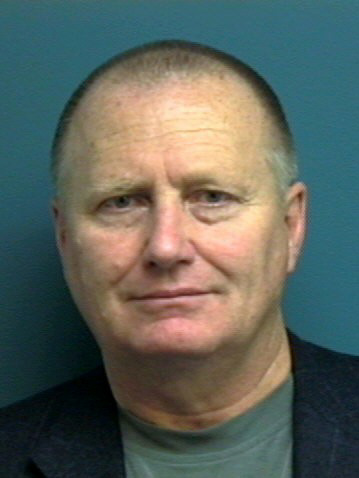 |
“David has performed great services for this laboratory, and this is another fabulous example,” Benson said. “I am confident that his leadership skills will ensure a positive outcome for the Laboratory and its operations.”
She said he will be working on complex, cross-cutting projects of strategic importance to the Laboratory, as well as providing strategic, procedural and policy advice to the senior management team.
McGraw will maintain his directorship of EH&S, albeit with a heavy reliance on his senior staff there. He also juggled responsibilities two years ago when Lab Director Charles Shank asked him to lead an effort to consolidate several units into the Public Affairs Department, now headed by Reid Edwards.
Since December, when the DOE expressed its intent to renegotiate a new management contract for Berkeley Lab with the University, McGraw and others have been preparing for negotiations on a new type of contract — one that incorporates “best practices” as defined by a three-lab pilot project conducted last year.
“Our goal is to have a contract that reflects operations performance tailored to our own particular mission and the applicable national standards,” he said. “We want to have accredited business systems, not just those defined by generic rules and orders.” Much of Berkeley Lab’s proposals stem from a comparison study with the NASA-run Jet Propulsion Lab in Pasadena and the NSF’s National Center for Atmospheric Research in Colorado.
The new contract is also likely to include “stretch science goals,” a new DOE concept that lists plausible and measurable objectives that programs can achieve over the five-year period of the contract. McGraw credited Institutional Planning Head Mike Chartock and Institutional Relations Head Karl Olson with much of the preparatory effort.
The current Lab contract, which officially expired last September, has been on monthly extensions while the negotiations teams prepare for discussions.
McGraw said he has reorganized his own EH&S operation to put many of the day-to-day responsibilities into the hands of Division Deputy Robin Wendt and senior staff Peter Lichty (operations and medical), Gary Zeman (radiation control), Nancy Rothermich (waste management), Ron Pauer (environmental management), and Don Bell (security). Paul Blodgett has been named Lichty’s deputy.
Published twice a month by the Communications Department for the employees and retirees of Ernest Orlando Lawrence Berkeley National Laboratory. Ron Kolb, Communications Department head.
EDITOR: Monica Friedlander, (510) 495-2248, msfriedlander@lbl.gov
STAFF WRITERS: Lisa Gonzales, 486-4698; Dan Krotz, 486-4109, Paul Preuss, 486-6249; Lynn Yarris, 486-5375
CONTRIBUTING WRITERS: Jon Bashor, X5849; Allan Chen, X4210
FLEA MARKET / CALENDAR: 486-5771
fleamarket@lbl.gov /currents_calendar@lbl.gov
Lawrence Berkeley National Laboratory,
Communications Department, MS 65
One Cyclotron Road, Berkeley CA 94720
Tel: (510) 486-5771 Fax: (510) 486-6641
Berkeley Lab is managed by the University of California for the U.S. Department of Energy.
By Paul Preuss
DOE’s emerging Science Grid hopes to do for the tools of science — computers and data-storage systems, telescopes, electron microscopes, synchrotron beam lines, even ocean-going floats that report via satellite — what the World Wide Web did for desktop PCs.
Visualization is one of the Grid’s most beguiling promises. Vivid images of otherwise hidden phenomena — exploding stars, folding proteins, turbulent fluid flows, the quantum states of subatomic particles — require masses of data. In the future, much of it could be generated in real time by far-flung networks of sensors. To live up to their billing, though, grid visualizations will have to evolve fast enough to allow direct interaction with researchers, perhaps many of them at once, scattered around the world.
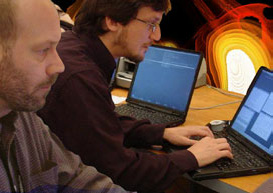 Wes Bethel and John Shalf led the winning Bandwidth Challenge team at SC2002. |
“The vision is a noble one,” says Wes Bethel, head of the Visualization Group in Berkeley Lab’s Computing Research Division, “but there is a huge gap between it and what can be done at present.” In a forthcoming issue of IEEE Computer Graphics and Applications, Bethel and colleague John Shalf discuss the “wide gulf between current visualization technologies and the vision of global, grid-enabled visualization capabilities.”
One of the most pressing issues is data-loss. Rather than concede that sometimes perfect accuracy isn’t needed, says Shalf, “Historically network specialists have a fear of lost data.”
The visualization community, on the other hand, “has long worked with missing data,” Bethel notes. “After all, MPEG movies and JPEG images are lossy, yet are widely accepted within the scientific community.” The challenge is to manage the loss of data used to create the visualization, not just what’s lost in compressing images.
At last year’s SC2002 conference in Baltimore, Bethel and Shalf headed a team that tackled the data-loss problem head on using Visapult, a program whose development was spearheaded by Bethel. In the process, Berkeley Lab won supercomputing’s annual Bandwidth Challenge for the third straight year.
Along with other advances, a custom data-transfer protocol was key to Visapult’s success. Bethel and Shalf dumped the familiar TCP (Transmission Control Protocol) favored by network specialists, which identifies individual data packets at the source, then reassembles them in precise order at the receiving end before the user ever sees the result.
Instead Visapult employed a version of the User Datagram Protocol (UDP), which merely sends packets from one machine to another. It’s up to the application to detect if they’ve arrived out of order or if any have been lost.
Visapult was used to view simulations of colliding black holes produced by the Cactus program, developed at the Albert Einstein Institute in Potsdam, Germany. Up to 16.8 billion bits a second streamed from the Cactus simulation to Baltimore through an intricate network of high-speed connections in the U.S. and Europe.
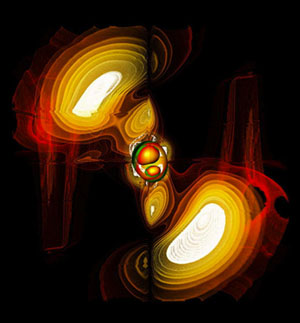 At SC2002, Visapult visualized a collision of two black holes, based on a simulation produced by the Cactus program. |
It takes a capacious transmission line — a “fat pipe” — to carry 17 billion bits a second. Because TCP data packets typically spend a lot of time on hold, waiting to be assembled in the right order or awaiting the retransmission of lost packets, even with a fat pipe TCP efficiency is only about 25 percent.
“The scientists all want fatter pipes,” Shalf remarks, “but if they can’t fill them, it will be hard for anyone to demand network improvement.” The custom UDP of the Cactus/Visapult combination used better than 90 percent of the available bandwidth to gulp from the Cactus data firehose.
A full-scale Cactus simulation requires three to five trillion bytes of data, which would seem to be far more than an interactive visualization could handle. But while one of the components of Visapult’s pipeline architecture is housed on a multiprocessor supercomputer, and imports and reads everything it gets, during first-stage processing, the data size is effectively reduced by an order of magnitude. The result, a partial visualization, is transferred to the Visapult viewer, which runs on a desktop workstation or a laptop computer.
Visapult is built for “latency tolerance.” Not all the data need even reach the back end before visualization and rendering begin; the viewer produces usable results without delay. As more packets arrive they are included to produce an increasingly detailed result. In Bethel and Shalf’s phrase, Visapult “tolerates loss gracefully” — and by design.
In this way the evolving visualization can keep up with the evolving simulation. If the scientist sees that a run is going awry, he or she can cut it short, or even adjust the code or the problem’s parameters on the fly.
Visualization will be one of the Science Grid’s primary tools for highly interactive, widely-distributed, multidisciplinary approaches to scientific problems. But much needs to be done, including more user-friendly access to visualization resources. Plenty of other challenges lie ahead in repairing what Bethel calls “the disconnect between the research community and science’s practical tools.”
Or, as Shalf says of prospects for improving Grid-based visualization, “It’s a work-rich environment.”
For more about grid-based visualization see http://www.lbl.gov/Science-Articles/Archive/CSD-the-grid.html.
Definitions of some terms used in “The Wizards of Vid”
Grid: A system for secure interaction among far-flung computers, data-storage facilities, instruments, and users. DOE’s Science Grid uses the Energy Sciences Network (ESnet) to link researchers and facilities at national laboratories.
Visualization: Images and movies systematically assembled from large datasets to represent things inherently invisible, purely theoretical, mathematically abstract, or just too vast and complex to grasp otherwise.
Protocols: Rules for managing information flow. Most internet traffic uses the Transfer Control Protocol based on the more general User Datagram Protocol (defined in main story).
Bits and Packets: A bit is a binary digit, 0 or 1, the smallest unit of data used by computers. A packet or datagram is a chunk of data tagged with addresses; it can travel the internet by different routes. The message or image is reassembled at the destination.
Multiprocessor: Many computer processors working in coordination to run a program simultaneously.
By Jon Bashor
Some quick thinking by Lab network systems engineer Greg Bell helped protect LBNL, ESnet and other DOE sites from the fast-spreading “SQL Slammer” worm recently.
While the Lab had contained the situation within two hours after discovering the attack on Jan. 24, other organizations weren’t so fortunate. Customers of major banks were unable to use ATMs that weekend, a major credit card company couldn’t provide users with access to their accounts, and the nation’s largest residential mortgage company was knocked offline for four days.
“Fortunately, our team did what we have come to expect from them — they performed well beyond any reasonable expectation,” said Sandy Merola, the Lab’s chief information officer and head of the Information Technologies and Services Division. “Their quick action helped protect both the Laboratory and other DOE facilities, even as other institutions were brought down by this denial-of-service attack.”
According to Internet Security Systems, the worm infected an estimated 247,000 systems. At the Lab, only a dozen systems were infected, and members of the Lab’s Computer Protection Program and ESnet (DOE’s Energy Sciences Network) credit Bell with putting up the first line of defense.
Bell, of the LBLnet networking group, was working online at home Friday night when Slammer first hit. A self-described email addict, Bell logged in to check his messages around 9:50 p.m., just minutes after the worm began its attack across the Internet. When he couldn’t connect over his DSL line, he became concerned and dialed into the remote access server. That connection worked, so Bell decided to investigate the problem with the Internet link.
“I looked at the border router traffic and saw there was a fire hose of malicious traffic going in and out,” he said. “Luckily, the worm had a simple pattern and I was able to block the port it was addressed to. Then our team swung into action and we worked together to contain the situation.”
Bell’s action prevented more Lab systems from becoming infected and kept the Lab from spreading the worm even farther.
According to Jim Mellander, the Lab’s cybersecurity incident response manager, the worm acts in a chain-reaction fashion: an infected system randomly scans for other vulnerable systems and infects them. The newly infected system then repeats the pattern, creating an explosion of network traffic. The result is that systems are so bogged down that they can no longer function, resulting in a denial of service. The Slammer worm uses Microsoft database products created with Structured Query Language (SQL) to scan for the same products on other systems, then infects them.
Fortunately, Mellander said, the worm does not damage or disable the system it infects, but needs to be taken off the network to stop its spread.
That’s what Bell did to the 10 infected systems after putting the router blocks in place and alerting the Lab’s computer protection staff and ESnet operators about the situation.
Mellander and Gene Schultz of the Computer Protection Program quickly began researching the worm and made sure that all Lab systems, including those at the Joint Genome Institute in Walnut Creek and in Washington, D.C., were blocked and protected. They continued working late into the night Friday and again the next day. By 1 p.m. Saturday, all essential Lab network services were restored.
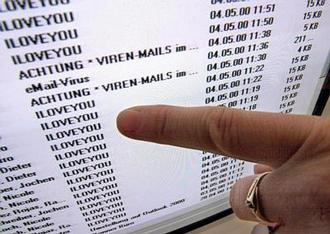 |
Working in parallel with the LBNL group was a team from ESnet, the network operated by the Lab to provide high-speed networking to researchers at national labs and universities around the country and overseas. Around 10:30 p.m. Friday night, an ESnet operator noticed that system routers were generating unusual log messages and realized something was wrong. A virtual team was quickly assembled and went to work. ESnet blocked all traffic coming in from “peering” networks through the port addressed by the Slammer worm.
“The important thing is that the network stayed up, though traffic for some sites was slowed down, and we were able to provide some protection to other sites,” said Mike Collins, group lead for ESnet’s Network Engineering Services.
The Lab effort also tapped the expertise of numerous other employees, including Mike Bennett, Joe Burrescia, John Christman, Jim Gagliardi, Chin Guok, Cedric Hui, Jim Leighton, Chris Manders, Roberto Morelli, Kevin Oberman, Dan Peterson, Ken Pon, Joe Ramus, Mark Redman, Ted Sopher and Clint Wadsworth.
Schultz, who is co-authoring a paper with Mellander and Dan Peterson on the worm attack, attributed the worm’s relatively minor impact on the Lab to increasing awareness on the part of the Laboratory of the need for heightened cybersecurity. Had that not been the case, Lab employees may have arrived at work Monday to find their networks down, their computers unusable and even some experiments out of action.
“It could have been a whole lot worse,” Mellander said
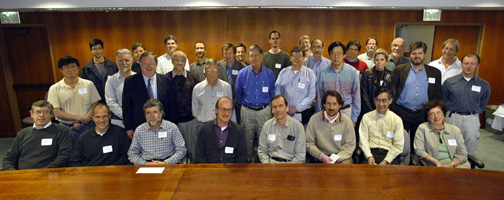 |
In Fiscal Year 2002, technology licensing agreements yielded $488,000 for 94 scientists whose inventions Berkeley Lab transferred to industry. Lab Director Charles Shank and the Technology Transfer Department awarded royalty distribution checks to 29 Berkeley Lab inventors who attended the annual royalty distribution ceremony, held on Thursday, Jan. 30. Fifty-two current Lab employees received royalty checks.
The average distribution was $5,192, with the highest check totaling more than $125,000. Distributions to inventors increased 49 percent over last year. Approximately $887,000 in additional licensing income will go to the Lab, to be used primarily for R&D.
Left to right are, in the front row: Ken Downing, Mark Modera, Fred Winklemann, Steve Holland, William Kolbe, Paul Adams, Robert Cheng, and Inna Dubchak;
Second row: Ocean Tseng, Tony Hansen, Director Charles Shank, Deputy Director Pier Oddone, Malcolm Howells, Joe Jaklevic, Dan Callahan, Joe Huang, Jamie Eberling, Krystoff Bankiewicz, Alexander Poliakov;
Back row: Lior Pachter, Nicolas Bray, Nigel Moriarty, Nick Sauter, Valeri Korneev, Erik Page, Earl Cornell, Craig Jacobson, Steve Selko-witz, Ralf Grosse-Kunstleve, (Walter) Fred Buhl, Lutgard DeJonghe, Steven Visco.
By Lisa Gonzales
Last week the Center for Science and Engineering Education (CSEE) launched a new tour program for local school children. In an ambitious education outreach effort, this spring CSEE will be providing field trips to the Lab for Oakland and Berkeley public school students. In all, 12 elementary schools, 12 middle schools, and eight high schools will be journeying up the hill for hands-on activities and demonstrations, as well as tours of our facilities and the opportunity to meet and talk with world class scientists.
“The Lab has always had tours, but this is the first time we are reaching out in a formal way to elementary school children as young as the fifth grade,” said Dale Koistinen, the new tour director for CSEE. A retired science teacher from the Oakland School District, Koistinen brings his enthusiasm for science and 38 years of teaching experience to the CSEE tour program.
According to Koistinen, outreach to elementary school students has been initiated as a result of the decision by the State of California to include, for the first time, science at the K-5 level as part of the mandated standardized testing that all students must undergo.
“In the elementary schools, they focus mostly on English and Math,” said Rollie Otto, head of CSEE. “The teachers have limited time and equipment to teach science in the classroom.”
In order to address the limitations of science in the classroom, CSEE has developed content for the field trips that is consistent with the State standards for the different grade levels. For the fifth graders who came to the Lab last week from Lafayette and Chabot Elementary Schools, that focus was on the structure of matter.
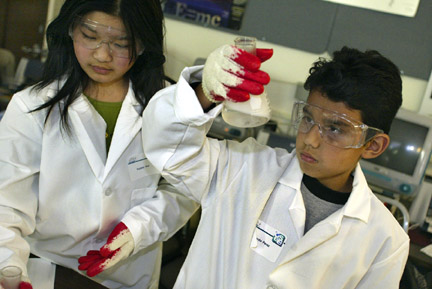 |
“Through discussion and experimentation, we addressed thermal conductivity, electrical conductivity, and combustion, and applied these to the structure of matter,” said Koistinen. These activities and demonstrations were followed up by tours of the ALS and the Protein Crystallography Lab, where scientists demystified their complex research so that the children could understand.
Edith Bourret-Courchesne of the Material Sciences and the Life Sciences Divisions also taught a lesson to the children on semiconductors.
“I looked at what they were learning, and I used that to discuss my own research,” said Bourret-Courchesne. For example, she showed them where semiconductor materials are located on the periodic table, and taught them some of the many applications for semiconductors.
“It was really a lot of fun. The children were so curious and the experiments were very well-prepared,” said Bourret-Courchesne, referring to the hands-on activities set up by CSEE, such as using dry ice to look at phase transitions, and circuit experiments that showed the difference between insulators and conductors.
It wasn’t all science, though. The children enjoyed a pizza lunch and a visit from some of our Lab firefighters, who gave a demonstration on the importance of fire safety.
However, no matter what was on the agenda, the most encouraging sign for all involved was the enduring curiosity of the students who had come to visit.
“The children asked a lot of questions about me personally,” said Bourret-Courchesne. “Why I study science, why I came here from France, how long I have been a scientist.” She believes that these questions are a clue to why scientists should participate in these education outreach activities.
“These kids are so lucky to be able to come up to a facility such as this at such a young age. It’s important for them to know that scientists are real people who don’t just exist in science fiction. This way they can begin to think of a future in science for themselves.”
Koistinen agrees. “The kids ask very intelligent questions,” he said, “and sometimes I’m surprised by how thoughtful they are.”
By Lisa Gonzales
The San Francisco Chronicle calls it the “Killing Zone.” Oakland beat cops call it “30X.” However, the students on the Castlemont Robotics Team call it their neighborhood. Castlemont High School, located in one of the most deadly zones in the state, has nonetheless produced a dedicated team of 20 students who are working with members of the Lab’s Engineering Division to compete for the fourth year in a row in the US FIRST Robotics Competition.
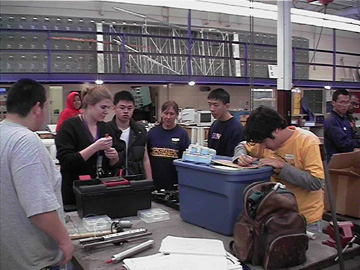 The Castlemont Robotics team works on the design of the "stack stealer," a robot that will be part of this year's FIRST Robotics Competition. Pictured along with the students are Castlemont teacher Erin Carlson (second from the left) and Deb Hopkins of Berkeley Lab (center). Lab intern Kivanc Aslaner is on the far right. |
In this year’s game, called “Stack Attack,” the robots collect plastic containers and stack them. The location and height of the stacks after the two-minute match determine the final score. US FIRST provides the basic raw materials. Design and building of additional parts is up to the individual teams.
“The Robotics Team is not only exposed to science and math beyond their regular classes, but they also get to see themselves in the world beyond East Oakland,” said Erin Carlson, an English teacher at Castlemont who is currently their team leader. The position of the team’s previous leader, the aeronautics teacher, was eliminated due to budget cuts. Now the team is working with no tools and no workshop. And the Feb. 18 deadline is fast approaching.
“We work with them two nights a week at the Lab and all day Saturday in a storage room at Castlemont,” says Deb Hopkins of the Engineering Division. “They are so dedicated, but there is only so much we can do when tools are scarce and they are having to do a lot of the work by hand.”
For those who are interested in helping the Castlemont Robotics Team, fundraising is an ongoing effort. Most needed now, however, are tool donations, especially power tools. For more information, contact Deb Hopkins at X4922.
Jay Krous of the Information Technology Services Division will be the speaker at the next computer protection brown bag, to be held at noon on Wednesday, February 12 in the Bldg. 50 auditorium.
The event will address the topic of computer vulnerability scanning and why the Lab goes through this process. Bring your lunch and your questions.
Jordan Hubbard, manager of Apple's BSD technologies group, will be the featured speaker at the next Mac User’s Group meeting, to be held on Thursday, Feb. 20 from 11 a.m. to 12:30 p.m. in the Building 50 auditorium.
Hubbard will talk about the integration of BSD and other open source technologies into Darwin and MacOS X. He will also touch on other subjects, such as Gnu libraries and gcc compiler plans, CUPS, support for scientific programming in Fortran, developer tools for Objective C, video CD's, and digital “convergence” issues.
Berkeley Lab's Dance Club will be offering a four-week salsa series for beginners starting on Thursday, Feb 20. Classes and practices are held at noon on Thursdays and Mondays in Bldg. 71, Room 146U. For more information contact Joy Kono at X6375.
The Telephone Service Center will hold its annual training session for all telephone coordinators on Tuesday, Feb. 25 from 10 a.m. to 12 p.m. in the Building 50 auditorium. Topics will include placing service orders, setting features, rates, voice mail, and products and services.
For more information or to register for the training, send an e-mail to Janice Smith (JLSmith@lbl.gov) or La Saundra Shields (LKShields@lbl.gov).
Participants in the March 15 symposium honoring Andy Sessler's 75th birthday are invited to make dinner reservations. The cost is $45 per person and includes cocktails, dinner with wine, and a musical interlude. Please RSVP to Tom Gallant (TGGallant@lbl.gov) no later than Feb. 7 and let organizers know how many persons will accompany you. Remit payment by check no later than Feb. 18. Checks should be made payable to Martha Condon, Mail Stop 71R0259 (1 Cyclotron Rd., Berkeley, CA 94720-8211.
The staff of the Accelerator and Fusion Research Division is organizing the event to celebrate Sessler’s scientific achievements and humanitarian contributions. The symposium will be held in the Building 50 auditorium on March 15. It is free and open to all. The dinner is limited to 140 guests.
Berkeley Lab’s dining service has started off the new year with a bang, bringing out a series of improvements and new selections at the cafeteria that should please the most discriminating of palates.
Included in the changes is a longer lunch period, now starting a half-hour earlier at 11 a.m. and continuing until 1:30 p.m.
The switch was instituted to accommodate employees who expressed interest in an earlier opening time at mid-day.
And what they find is a revamped menu that includes new weekly offerings, more desserts, new energy drinks and more snacks. The offerings include:
NEW EMPLOYEE ORIENTATION & EH&S TRAINING
Starts at 8 a.m., Bldg. 50 auditorium
COMPUTER PROTECTION BROWN BAG
Noon, Bldg. 50 auditorium
NEW DANCE CLUB SERIES STARTS
Noon., Bdlg. 71-146U
SHOEMOBILE
7:30 a.m. – 3:30 p.m., cafeteria parking lot
MAC USERS GROUP MEETING
Noon, Bldg. 50 auditorium
Send us your announcements
Announcements for the General Calendar and Bulletin Board page may be sent to msfriedlander@lbl.gov. Seminar & Lectures items may be mailed to currents_calendar@lbl.gov. You may also fax items to X6641 or mail them to Bldg. 65. The deadline for the Feb. 21 issue is 5 p.m. Monday, Feb. 11.
DEPARTMENT OF PHYSICS COLLOQUIUM
First Results from the Kamioka Liquid Scintillator Anti-Neutrino Detector
Speaker: Stuart Freedman, UC Berkeley
4:30 p.m., 1 Le Conte Hall
EXPERIMENTAL SYSTEMS GROUP MONTHLY MEETING
Upgrading the ALS
Speaker: David Robin, ALS
9:00 a.m., Building 2, Room 100B
CENTER FOR BEAM PHYSICS SEMINAR SERIES
Limitation of Electron Beam Conditioning for FELs
Speaker: Gennady Stupakov and Paul Emma, SLAC
10:30 a.m., Albert Ghiorso conference room (Building71-264)
Refreshments at 10:20 a.m.
LIFE SCIENCES DIVISION DISTINGUISHED LECTURER
Recent Duplication and Dynamic Evolution of the Human Genome
Speaker: Evan Eichler, Case Western Reserve University
4:00 p.m., Building 66 auditorium
PHYSICAL BIOSCIENCES SEMINAR SERIES
Speaker: Eva Nogales
2:00 p.m., Perseverance Hall
SURFACE SCIENCE AND CATALYSIS SEMINAR SERIES
Vibrational SFG Spectroscopy on Pd Nanoparticles and Pd(111): Adsorption
and
Reactions from UHV to Atmospheric Pressure
Speaker: Gunther Rupprechter, Fritz-Haber Institute, Berlin
1:30 p.m., Bldg. 66 auditorium
CompUSA provides onsite PC computer courses to Lab employees. The cost for all day-long courses is $199. Classes are held in Building 51L from 9 a.m. to 4 p.m.
|
Date |
Course |
|
2/11 |
XML |
|
2/12 |
PowerPoint 2000 Level 2 |
|
2/26 |
Dreamweaver 4.0 Introduction |
|
2/27 |
Excel 2000 Level 2 |
|
3/11 |
Presentation Skills using PowerPoint |
|
3/12 |
Excel 2000 Level 3 |
|
3/13 |
Web Publishing with Adobe Acrobat 4.0 |
|
3/27 |
PowerPoint 2000 Level 3 |
|
3/31 |
Dreamweaver 4.0 Intermediate |
Class descriptions and registration procedure are available online at the employee self-service website, https://hris.lbl.gov/. For more information, to request a class, or to provide feedback about the program, contact Heather Pinto at hmpinto@lbl.gov.
|
Date |
Course |
Time |
Building |
|
|
2/4 |
EHS 60 |
Ergonomics for Computer Users |
9:00 – 10:30 |
51-201 |
|
2/5 |
EHS 116 |
First Aid Safety |
1:00 – 4:00 |
48-109 |
|
2/5 |
EHS 278 |
Ladder Safety |
9:00 – 10:00 |
51-201 |
|
2/5 |
EHS 279 |
Scaffold Safety |
10:00 – 11:00 |
51-201 |
|
2/6 |
EHS 256 |
Lockout/Tagout |
10:00 – 11:30 |
51-201 |
|
2/7 |
EHS 345 |
Chemical Hygiene for Facilities |
10:00 – 12:00 |
51-201 |
|
2/10 |
EHS 275 |
Confined Space Hazards |
8:30 – 11:00 |
51-201 |
|
2/10 |
EHS 274 |
Confined Space-Retraining |
11:00 – 12:00 |
51-201 |
|
2/10 |
EHS 330 |
Lead Hazards Awareness |
1:00 – 2:00 |
51-201 |
|
2/11 |
EHS 10 |
Introduction to ES&H at LBNL* |
8:00 – 10:15 |
50-aud |
|
2/12 |
EHS 123 |
Adult Cardio-Pulmonary Resuscitation |
2:00 – 4:00 |
48-109 |
|
2/12 |
EHS 61 |
Ergonomics Evaluators Training |
9:00 – 11:30 |
51-201 |
|
2/13 |
EHS 135 |
Earthquake/Wildland Fire Safety |
10:30 – 12:00 |
48-109 |
|
2/13 |
EHS 260 |
Basic Electric Hazard Awareness |
1:30 – 3:00 |
51-201 |
|
2/18 |
EHS 348 |
Chemical Hygiene Safety |
9:00 – 12:00 |
51-201 |
|
2/18 |
EHS 231 |
Compressed Gas |
1:00 – 3:30 |
51-201 |
|
2/19 |
EHS 530 |
Fire Extinguisher |
2:00 – 4:00 |
48-109 |
|
2/25 |
EHS 604 |
Hazardous Waste Generator |
9:30 – 11:00 |
51-201 |
|
2/25 |
EHS 622 |
Radioactive & Mixed Waste Generator |
11:00 – 12:00 |
51-201 |
|
2/25 |
EHS 735/ 738/739 |
Biosafety/Bloodborne Pathogen |
1:30 – 2:45 |
51-201 |
|
2/26 |
EHS 280 |
Laser Safety |
9:00 – 12:00 |
51-201 |
|
2/26 |
EHS 60 |
Ergonomics for Computer Users |
1:30 – 3:00 |
51-201 |
|
2/27 |
EHS 400 |
Radiation Protection-Fundamentals |
9:00 – 12:00 |
51-201 |
|
2/27 |
EHS 20 |
ES&H for Supervisors |
1:30 – 3:30 |
51-201 |
|
2/28 |
EHS 432 |
Radiation Protection-Lab Safety |
8:00 – 12:30 |
51-201 |
* Includes EHS 392/405, followed by the orientation.
To enroll, contact Valarie Espinoza-Ross at VMEspinoza-Ross@lbl.gov or enroll via the web at https://hris.lbl.gov/self_service/training/. Preregistration is required for all courses except EHS 10. For a full, updated schedule, see http://www-ia1.lbl.gov/schedule/.
‘99 HONDA TRX 300, ATV, red/blk, 5 spd, 2 wd (2X4), exc cond, $3,800/bo, John, 531-1739
‘98 MAZDA 626 LX, 93K mi, mt, ac, all pwr, alarm, am/fm/cd, tilt wheel, cruise, sliding sunrf, alloy wheels, exc cond, clean, $6,300/bo, 925-422-6013 (day), 595-1755 (eve)
‘98 FORD EXPLORER, XLT, 4 wd, exc cond, many opts, 64K mi w/ transferable 90K Ford warranty, recent 60K major service, new brakes, $12,250/bo, Victor, X7929, (925) 462-0468
‘93 TOYOTA COROLLA, 4 dr sedan, 5 spd, 109K mi, $3,600/bo, great car, Jenn, 665-5827
‘90 VW JETTA, 101K mi, at, sunrf, runs exc, good mpg, $2,300/bo, Tim, X7810, 865-4308
BERKELEY HILLS, beautiful lge 1 bdrm apt, furn, marble bth, kitchen, priv patio, no smoking/pets, $1,295/mo + util, Helga, 524-8308, ivankash@hotmail.com
BERKELEY, resid community of UC scientists, Lab personnel & grad students, Hearst Commons, 1146-60 Hearst near University/San Pablo, close to pub trans & bike path, reserved parking, studio townhouses w/ decks, hardwd flrs, skylights, dw, ac, intercom, sec, $895, avill through Jun/Jul, longer term also avail, Alan, 666-1150, editeur@earthlink.net
CENTRAL BERKELEY, nice furn rms, kitchen, laundry, TV, DSL, hardwd flrs, linens, dishes, contin breakfast, walk to pub trans/shops, $950/mo incl utils, $350/wk, Jin or Paul, 845-5959, jin.young@ juno.com, Paul X7363
EL CERRITO, avail now, 2 bdrm/1 bth, semi-formal din area w/ chandelier, priv garden, alarm, 3 blocks to BART & freeway, walk to shops, maint secluded yard, laundry, very quiet, great neighborhd, $1,195/ mo, Andy, 724-3089
ELMWOOD, share elegant 11-rm house w/ 2 professionals, 35+, nonsmoking, lge bdrm w/ big closet, avail 2/8, weekly shared dinners, yellow Lab, sauna, fp, fishpond, $750/mo + dep, shared expenses, Tony, 841-4480
MARTINEZ, rm in 4 bdrm/ 2 bth home, close to freeway & shops, utils incl, $600/mo neg, Emily, (925) 383-5485
NORTH BERKELEY HILLS, bay view from 17x15 furn single rm, own bth, priv entr, cooking facilities in rec rm w/ w&d, lge fridge, pool table, workout mach, quiet/safe neighbrhd, near UC, pub trans & shops, $850/mo, incl linens, dishes, utils, phone line, internet, use of garden/BBQ, no smoking, avail Jan-May w/ neg ext, Carol, 524-6692
NORTH BERKELEY HILLS, shared house,10-min walk to LBNL, furn rm, own bth + use of kitchen, use of own comp on DSL line, $750/mo, avail to LBNL visiting scientist, vgo@pacbell.net
PIEDMONT, furn 1 bdrm apt, liv rm, study, kitchen & patio in secluded area, $1,350/mo include utils, avail now for short-term or until end of June, Julie, 452-0790
WALNUT CREEK, 1601 Alvarado Ave, lge 1 bdrm apt on ground floor of 4 plex, patio, carport, pool, avail after 2/1, $850/mo, Bob, (925) 376-2211
EL CERRITO house for sale, 2 bdrm/1 bth, hardwd flr in liv & din rms, remod kitchen, 1 car garage, close to BART, 15 min to LBNL, $339,000, 724-9450
ELECTRIC STOVE, self-standing w/ oven, white, 30" wide, never used, Kenmore, $100, Daniela, X6234
FURNITURE, liv & din rm, shaker style, like new, blonde finish, 6-drawer maple dresser (53"x30" x19"), $450; lge maple bookcase (36"x72"x12"), $325; sm maple bookcase (36"x30"x12"), $125; maple nightstand w/ 1 drawer, $150; maple nightstand w/ 2 drawers, $75, Charles, 841-7541, 334-8567
MOTHERBOARDS, brand new: Intel SE440BX P2/P3 up to 450mhz, $15; Legend-QDI P4 up to 2ghz, $40; brand new Philips/ Magnavox WEBTV, $50, Steve, X2525
PIANO, ‘63 Wurlitzer spinet w/ beautiful walnut finish, exc cond & tone, $1,200, Tennessee, (925) 487-8882
SCHWINN BIKE, Gremlin 12", exc cond, training wheels, $90/bo, Mark, X6581
SF SYMPHONY TICKETS, 4 tix/$59, parking pass, $9.50, Mar 8, 8 p.m., all Prokofiev piano conc & symph #3, orchestra, row N, will sell as 2 prs, Mark, X6581
SOFA, brand new lt tan w/ blue & burg on cushions, $300/bo, Kelly, X7461, (926) 679-3123
CONSUMER ELECTRONICS, only partly working, Sherwood RX4103 am/fm stereo receiver, technics amplifier, JVC cd player, Panasonic HiFi VCR, badminton set, Jon, X5974
CONDOMINIUM for 3-4 days in the Monterey/ Carmel area for July, Diana, X4070
FRENCH CONVERSATION partner, adv beg, once a wk, Avril, X4098
FOUND: sunglasses in burg soft case in parking area downhill from cafeteria, Sherry, X4115
LOST: glasses, on 1/24 between cafeteria parking lot near the main entr & Bldg 2 conf rm 100: wire rimmed bifocals in a dark blue case w/ a script CAL on it, Julie, X4583
KAPAA, KAUAI, 2 bdrm oceanfront condo at Kapaa Shore Resort, pool, spa, tennis, fully equipped, ocean view, 3rd floor lanai, sleeps 6, walk to shops & dining, no smoking, $145/ day, $850/wk + tax + outcleaning fee, Richard, X6320, 845-1723
TAHOE KEYS at S. Lake Tahoe, 3 bdrm house, 2-1/2 bth, fenced yard, quiet, sunny, skiing nearby, great view, $195/night, 2 night min, Bob, (925) 376-2211
Ads are accepted only from LBNL employees, retirees, and onsite DOE personnel. Only items of your own personal property may be offered for sale.
Submissions must include name, affiliation, extension, and home phone. Ads must be submitted in writing via e-mail (fleamarket@ lbl.gov), fax (X6641), or delivered/mailed to Bldg. 65.
Ads run one issue only unless resubmitted, and are repeated only as space permits. They may not be retracted once submitted.
The deadline for the Feb. 21 issue is Thursday, Feb. 13.